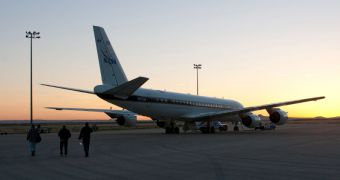Starting on Monday, March 22, NASA will resume observations in the largest airborne survey of polar ices in history. The Operation IceBridge mission is about to kick off its second year of observations, and the moment will be marked by the arrival of some NASA-operated aircraft in Greenland. The reason why this study is conducted from airplanes rather than satellites is the fact that NASA lost its ICESat (Ice, Cloud and land Elevation Satellite) mission, while the replacement spacecraft, ICESat-2, will only be launched in 5 years.
“NASA's IceBridge mission is characterizing the changes occurring in the world's polar ice sheets. The mission's goal is to collect the most important data for improving predictive models of sea level rise and global climate change,” says cryosphere program manager Tom Wagner, who is based at the NASA Headquarters in Washington DC. The main target of the investigation will be tracking and analyzing changes in the extent and thickness of polar ices. Researchers say that this is the most important factor in understanding ice dynamics, which ultimately dictate how ice sheets will perform over time.
The spring 2010 campaign will require NASA aircrafts and pilots to fly about 200 hours of missions above the ices in the Arctic and Greenland. As such, engineers have been preparing for this by installing a wide array of scientific measurement equipments on the space agency's DC-8 airplane, which is regularly used for such missions. Between 10 and 12 science flights will be conducted overall, spaced over a period of some 5 weeks. Arctic sea ice and Greenland ice sheet and outlet glaciers will be the main point of interest in this year's survey.
“NASA has a unique capability to look at these things from a bird's-eye perspective, not only from space but also from multiple long-range, high performance aircraft. If not for IceBridge, the global science community and the public would miss out on a great deal of knowledge about Greenland and Antarctica,” adds IceBridge management team member John Sonntag, who is also a senior scientist at the Wallops Island, Virginia-based URS Corporation. Numerous NASA centers and American universities are involved in planning, developing, and managing the IceBridge program.

 14 DAY TRIAL //
14 DAY TRIAL //